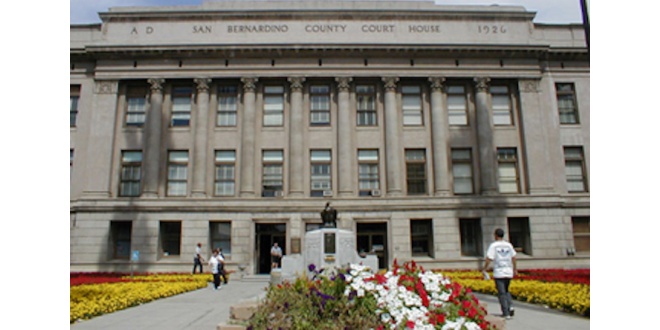A proposed warehouse-distribution project that would cover 213 acres has been tripped up, at least temporarily, by a flawed environmental impact report compiled by San Bernardino County.
Bloomington Business Park would bring 2.1 million square feet of warehouses to Bloomington, an unincorporated community of approximately 23,000 residents in San Bernardino County near Fontana and Rialto.
But in a decision handed down last month, San Bernardino County Superior Court Judge Donald Alvarez blocked construction of the project, saying it does not comply with the California Environmental Quality Act.
In a 100-page ruling issued Sept. 17, Alvarez said the report failed to take into account how much the project might hurt air quality, whether it might produce more than an acceptable level of greenhouse gas emissions, how much noise it might generate, and whether it would use enough renewable energy sources.
Alvarez ordered the county to set aside its certification of the environmental impact report, and said no construction can be started until those problems are corrected.
That ruling drew praise from environmental groups, including the Center for Community Action and Environmental Justice in Jurupa Valley, one of the four organizations that filed the lawsuit on behalf of residents near the proposed project site.
The People’s Collective for Environmental Justice, the Sierra Club and the Center for Biological Diversity were the other plaintiffs.
“Residents near the project site objected to it for all of the usual reasons,” said Ana Gonzalez, the center’s executive director, in a telephone interview. “They don’t want to deal with excessive noise, traffic and air pollution, which is what would happen if the project was built as planned.”
In a statement,Gonzalez said her organization was “happy, relieved, and inspired” by the court’s decision, and called Bloomington Business Park “a destructive plan” that would have destroyed nearby neighborhoods.
That plan called for Howard Industrial Partners in Orange to build the project in a rural area one mile south of Interstate 10. The project site is bordered by Santa Ana Avenue on the north, Jurupa Avenue on the south, Linden Avenue on the east and Alder Avenue on the west, according to the county’s specific plan.
Large logistics projects often engender public opposition, but there were several factors regarding Bloomington Business Park that make if different from other large warehouse-distribution projects in Riverside and San Bernardino counties.
More than 100 homes were demolished, and Zimmerman Elementary School, a K-6 campus at 11050 Linden Ave., also is to be torn down and replaced.
The Center for Community Action’s next goal is to get compensation for everyone who lost their place of residence, an action that might require another lawsuit.
“In the past we’ve made concessions with developers, but that doesn’t help the community avoid the environmental issues associated with these projects,” Gonzalez said. “That approach has a (negative) cumulative affect.”
Tim Howard, partner with Howard Industrial, declined to comment.
As for Zimmerman Elementary, Howard Industrial and the Colton Joint Unified School District reached a $44.5 million deal which will allow the district to build a new school well away from the business park site.
Howard Industrial has also agreed to pay $39 million for street improvements, $30 million for flood control and $1.1 million for extra police, said David Wert, San Bernardino County public information officer.
The project is expected to create more than 3,200 permanent jobs and 5,400 construction jobs. Approximately 480 apartments and condominiums will be built near the project site for people who had to surrender their homes, Wert said.
He declined further comment.
The Inland Empire is sometimes called the warehouse of the western United States, for good reason.
Because of its easy access to multiple freeways, proximity to the ports of Los Angeles and Long Beach, and its ample supply of affordable open land, the region over the years has become home to more than one billion square feet of industrial space.
But after more than 25 years of that development, some people in the Inland Empire have had enough. Maybe not of industrial development entirely, but enough of industrial development that they believe are too close to neighborhoods and schools.
In July 2023, the Fontana City Council voted 3-2 against a proposal that would have put three warehouses – a total of roughly 540,000 square feet – next to Jurupa Hills High School. That project was approved four months later.
One year ago, the Beaumont City Council turned down a 2.5-million-square-foot industrial project that would have been constructed next to Interstate 10.
And, in April of this year, the Moreno Valley City Council said no to a 1.3-million-square-foot industrial project that was to have been part of the World Logistics Center, a planned $25 billion industrial development in Moreno Valley.
At buildout, the WLC will contain 40 million square feet of industrial projects spread over 2,600 acres, making it one of the largest projects of its kind in the United States, if not the world. Approved by the Moreno Valley City Council in 2015, the WLC broke ground in 2023 and is expected to be completed in about six years.
All of those projects encountered opposition from local residents and environmental groups, and the battle regarding Bloomington Business Park is in the same vein, according to Gonzalez.
“I think this is the tipping point, even more than the World Logistics Center, in terms of resistance to these kinds of projects,” Gonzalez said. “In the case of Bloomington Business Park some people lost their housing, and a school will be shut down. Nothing like that happened with the World Logistics Center.”
That resistance doesn’t mean advocating for an outright ban, however.
“We aren’t trying to stop these projects,” Gonzalez said. “We understand that we need them to move goods, and that they create jobs that pay well. We just don’t want them in the wrong place.”
 IE Business Daily Business news for the Inland Empire.
IE Business Daily Business news for the Inland Empire.


